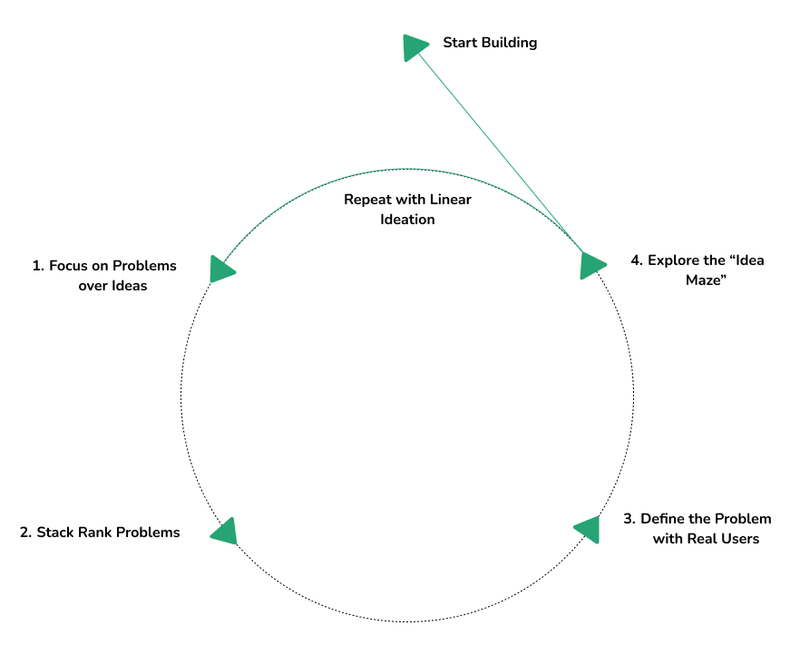Developing good startup ideas is hard. Great ideas and downright horrible ideas are often initially indistinguishable and somewhat bad ideas often look so tantalising until you’re really in the weeds with them.
The Ideation Flywheel is a mental model to help you think about which startup ideas are worth pursuing and, more importantly, how to improve your ideas by testing them without bias.
1. Focus on problems
The first step is forgetting about startup ideas entirely - thinking only in “idea space” is a surefire way to come up with solutions in need of problems or solutions for problems that don’t really exist.
So, how do we surface problems? This is actually pretty hard. For a lot of us, life is mostly good. The trick therefore, is to become someone that starts to notice problems. I know this sounds like reductive advice, but it's a necessary precondition to finding problems worth solving.
You can do this in various ways, including:
- Keeping a notebook or note in your phone to jot down when you notice something suboptimal.
- Looking back into your professional and personal life - think about your current job, your previous jobs, internships etc - what sticks out as particularly painful?
- Asking people you know - what are people consistently complaining about in the pub or around the dinner table?
The core theme in all of the above tips is to remain continuously curious of the world, people, and their problems.
2. Stack rank problems
Now you have a list of possible problems you could work on. How do you decide which among them is the best use of your time and resources?
You need some sort of rubric to grade them. You may want to rank the problems on the following characteristics:
- How painful is the problem? Is it a mild irritation, or does it cause intense pain? Quantify this if you can - how many hours (or how much money) do people spend hacking their way round the problem, or how much time or money could be unlocked if there was a solution to it?
- How large is the market (in terms of $ spent per year on this problem) or how large could it be at some point in the next 7 years? This is particularly important if you wish to raise VC funding.
- To what extent are you uniquely capable of solving this problem? Do you have an unfair advantage in solving this problem (access, knowledge, experience)?
- How strong is your personal interest in this problem? Passion sustains you when things get hard. Pick problems you're passionate about.
- How confident are you that there is a path to monopoly in this market?
- What is the Miracle Count? How many big bets (miracles) do you think you'll need to pull off to have success solving this problem?
- Has something fundamentally changed about the market landscape? E.g. new regulation.
- Has there been a step change in some technology that could be used to solve this problem? Be careful not to slip into solutionising yet, you might be wrong about this technology's suitability.
- Finally, upweight problems which are either (a) Frequent, painful and pervasive, or (b) Felt sharply by a small number rather than somewhat felt by a large number (on the margin).
There is no "correct" way to grade problems for stack ranking. However, I would make sure that any problem you choose to work on scores highly on both:
- Market, or potential market, size - great markets pull products out of startups.
- Your personal interest in the problem - failure doesn't happen when you run out of money, it happens when you give up. Make sure you have enough interest to keep motivated through the inevitable ups and downs.
3. Crisply define the problem with real users
It’s very tempting, once you have decided on a problem, to jump in with all the possible solutions that come to mind. Hold that thought. First, you need to deeply understand the problem.
The only way to do that is to speak with people that actually have the problem. However, to gain a useful understanding you need to conduct these conversations in the correct way.
The single best resource to learn how to do this is called the Mom Test by Rob Fitzpatrick. I recommend you pick up a copy before you conduct a single interview, but I’ll give you the overview here:
- You shouldn't ask anyone whether your business is a good idea. It's a bad question and invites everyone to lie to you at least a little.
- Talk about their life instead of your idea - the goal of the interview is to extract data about the problem, not to sell your eventual solution.
- Ask about specifics in the past instead of hypotheticals or opinions about the future.
- Understand the context around the problem - what was their path to encountering the problem? How does this problem interact with their life? What are their motivations for tackling the problem?
- Talk less and listen more - if you’re talking about your idea (or anything else) they aren’t talking about their problems - remember you’re there to learn.

4. Explore the "Idea Maze"
The first step into the Idea Maze is really understanding the problem. Hopefully, through your interviews, you will have built this understanding. Continuing to walk through the Maze is the essence of foundership because, in some sense, you’re never really out of the Maze.
But what do these early steps look like?
- Researching what possible solutions exist to the problem you now understand.
- Understanding the constraints of potential customers - budget, time, knowledge etc.
- Understanding how the Maze is changing over time - you want to navigate to where the ball is going to be.
- Understanding what a minimal feature set looks like to solve the core burning problem - you don’t have the luxury of years of development and tonnes of cash (and even if you did, you shouldn’t spend it now).
- Understand what a 10x improvement looks like - 10x is important - you are an unknown startup, it’s not enough to be just slightly better than the competition.
- Understanding how you can be different and not merely better - you need to be able to stand out in a crowded market - it’s good to have heretical views and seek to occupy an opposing position to incumbents. Bonus points if you set yourself up to do something they cannot do (e.g. because it would destroy their margins).
Your journey is going to be unique to you and your idea. However, I do want to share some generally applicable tips as you start out navigating the Idea Maze.
- Look for clues in history - it's highly unlikely you're the first person to try to solve this problem.
- Don’t be afraid of others in the Maze with you - learn what you can and recognise any problem worth solving is going to have many people trying to solve it.
- Some turns lead to dead ends - that’s fantastic news, it's simply an hypothesis debunked and wasted time avoided.
Now things can go 1 of 2 ways.
The much more likely path is that, through your exploration, you conclude that this problem is not solvable (yet), not solvable for you, or perhaps not worth solving. This may be for a multitude of reasons. Maybe the timing is not right, maybe you are not the right person, maybe you have the skills but you realise you don’t have a burning passion to work on this problem for years on end, or maybe the market is smaller than anticipated. That’s all ok, it's actually to be expected.
That’s why there is a stage 5 (or why this framework is a flywheel).
5. "Linear Ideation" (restarting the flywheel)
Take what you’ve learned from your exploration and feed that back into the next round of ideation - but crucially, do not throw away your research. Retaining and using the knowledge and experience you've acquired is the principle of linear ideation.
As you explored the idea maze you will have found other clues which might lead to an even greater treasure. Maybe you found new but related problems to add to your list of problems or maybe you found new information which impacts the stack ranking of your problems.
Above all, you will have contacts and experience in a problem domain through your research and your interviews which can be leveraged in the next round of ideation. Don’t start all over from scratch, preserve the value you’ve created in previous rounds of ideation to propel you to the next.
Good Luck
At Stackfix we believe that startups have the potential to change the world in meaningful and hugely positive ways. We hope this framework is helpful as you begin to think about the problems you're passionate about and which you're uniquely positioned to solve.
Camin McCluskey is Co-Founder of Stackfix. Stackfix helps startups find the right software, fast. If you or any company you know are looking for CRM / Customer Support / Applicant Tracking / HRIS software - go to www.stackfix.com (it's totally free).
